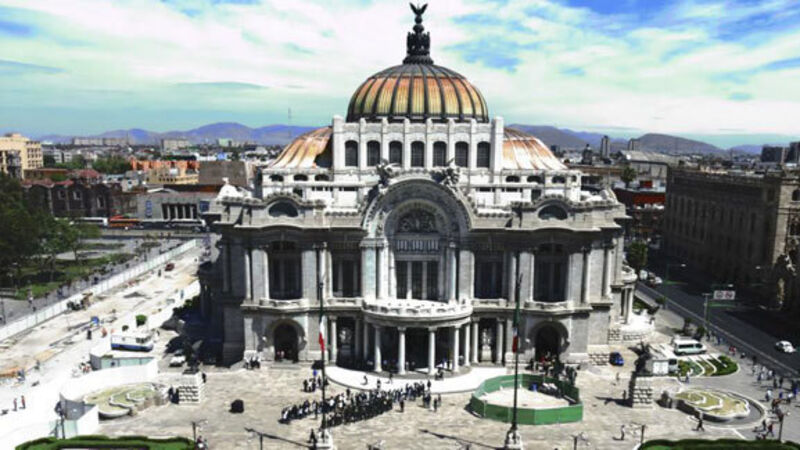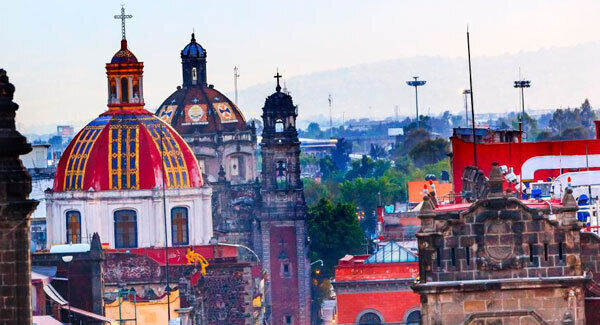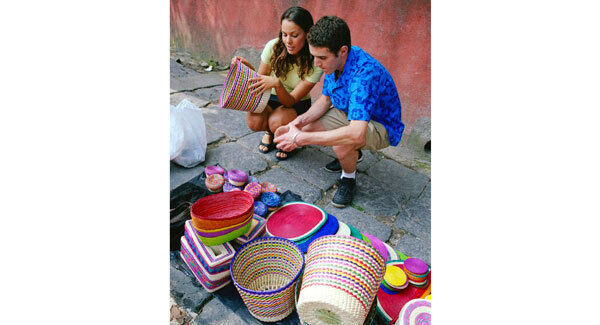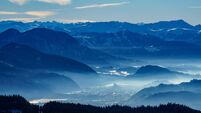Mexico City is huge, and a sight to behold

MEXICO CITY is huge. It has a population of about 20 million. It is a surprise, however, to discover how easy it is to wander around its streets.
While it once had a reputation for being a dangerous place — locals like to say “Mexico City is the safest place in Mexico” — it is not as intimidating as other Latin American cities like, say, Caracas, to go walkabout.
Neither does Mexico City have many skyscrapers. It’s not a concrete jungle. Most buildings are only a few stories high, and often flat-topped or of a charming colonial style. Its streets are broad and mainly tree-lined.
And the mountain ranges and 11 volcanoes (active, dormant and extinct) that encircle the city can be spied from most inner-city vantage points. This gives Mexico City (or DF, Distrito Federal, as South Americans call it) a spacious, un-crowded feel.

The only downside, for the tourist who likes to walk, is that the city sprawls. If you’re headed somewhere beyond the metro map, it can take a while to get there.
You can take a (crowded) bus, which is an experience worth trying if only for the buzz of being in a big, sweating vehicle speeding down a dual carriageway while the passenger door is left open to let in some air.
The alternative is to get a taxi. This offers more unexpected entertainment. City guides warn gringo tourists not to hail taxis from the street, as some of the unregistered taxis have been known to kidnap their passengers. It’s best to order taxis from officially registered companies.
During one day of bombing around the city, I had to take three cab rides. Two of the three taxis mysteriously got lost, which entailed fishtailing around the city’s cavernous neighbourhoods as if Detective Popeye Doyle from The French Connection was at the steering wheel. All the while, the meters were running, of course.
The routes back to our destinations involved the taxi drivers jumping dramatically out of the car every now and again to get our bearings. Once, one of the taxi drivers hung himself out of his window to get a lock on our whereabouts from a lorry driver perched way above us.
I thought he was going to put his back out. The other lost taxi driver roped a random guy on the side of the street to sit shotgun for a stretch until he could guide us home. Two lost taxis out of three in one day seems a lot. Maybe I was unlucky. Or maybe I was taken for a ride.
Mexico’s metro, too, is an interesting jaunt. It’s jammers at rush hour and if you’re unlucky enough to be caught by a door — brace yourself each time you get to a station because you will be properly chucked to the ground as the passenger tributaries disgorge.
They’re flooded with street vendors selling their wares, which is fine, but I vividly remember passing one street-trader in particular with a baby and toddler playing by her feet as she tried to hawk some cleaning products, which was a common sight.

The number of maimed people on the city’s streets is striking, a nod towards swathes of poverty and a poor public health system. Also quite a lot of people amble about wearing paper masks to shelter from air pollution. The city has been planting lots of “green roofs” on its hospitals, schools and government buildings as part of an attempt to solve a long-running problem with smog.
It’s a shame because a regular feature is to hear birdsong amongst the quieter parts of the city.
Kids hustle in the middle of traffic for pesetas by either offering window-cleaning service for motorists or the more inventive ones go in for a bit of street entertainment — juggling oranges, twirling hula hoops or fire-eating, and these are 10-year-old kids or at a stretch young teenagers.
The Zócalo, which means “base”, is the main plaza in Mexico City. It is a sight to behold, and one of the largest city squares in the world. It has been the site of some historic protests — and epic games of human chess — over the years.
In the middle of it flutters a giant Mexican flag, which is raised ceremoniously each morning and lowered at around six o’clock. On one side rests the Metropolitan Cathedral, on another the presidential palace.
The National Museum of Anthropology is a must-visit in the city, and the most visited museum in the country. It houses some fascinating artefacts, unsurprising given Mexico’s Azteca history.
These include the famous Stone of the Sun, an Azteca calendar dial which is about 12 feet in diameter. Archaeologists reckon that it was more likely used as a ritual altar for gladiatorial sacrifices than for helping to get a handle on astrological puzzles.
There are a couple of standout restaurants in the city centre. La Casa de Azulejos is the flagship restaurant of the Sanborns. It’s a converted eighteenth century palace which looks a bit like a spacious version of Bewleys on Grafton St, with ornate finishings and a Moorish fountain.
It’s tiled outside as its translated name (“House of the Tiles”) infers, with elaborate, multi-coloured tiles all over the walls and its three stories, most of which were produced in China and shipped to Mexico.
Café la Habana is the city’s most storied café. It’s here where Fidel Castro and Che Guevara plotted the Cuban Revolution in the late 1950s, and has been a popular haunt for literary types down through the ages, including Gabriel García Márquez and Roberto Bolaño. The late Bolaño set part of his novel The Savage Detectives in the café, although he re-named it Café Quito.
The white-marbled Palacio de Belles Artes houses some of Diego Rivera’s gigantic murals, including Man at the Crossroads, the original of which was commissioned for New York’s Rockefeller Center, but the Rockefellers took an axe to the fresco because of its anti-capitalist messages, which included an image of a Soviet May Day Parade. Rivera reproduced it back in his homeland in 1934.
The gallery also contains murals by a contemporary of Rivera — the talented but strange David Alfaro Siqueiros. He fought in the Spanish Civil War and in May 1940 led an assassination attempt on Leon Trotsky who had moved to Mexico City in 1937.
Trotsky had been on the run for years from Stalin. All four of his children were either murdered or committed suicide, the manhunt for their father having become so stressful.
The tour guides at Trotsky’s old house in the Coyoacán neighbourhood tell the account of the Trotsky assassination attempt by Siqueiros with gusto.
Most of his accomplices — about 20 in total — were drunk, having got charged up on liquor for courage. They were too scared to scout the house for Trotsky who they believed had superhuman strength and so just sprayed the house with bullets for a few minutes and then legged it.
The rooms inside the house are riddled with bullet holes to this day. Remarkably, Trotsky and his wife emerged unscathed. Only their grandson — who still lives in the neighbourhood, now aged in his late eighties — was shot in the leg.
A few months later Ramón Mercader did for Trotsky with an ice pick. Mercader’s plot was far more elaborate. He was a Russian agent, born in Barcelona. Having spent a lot of his youth in southern France, he spoke perfect French.
He went to Paris where he masqueraded as a Belgian businessman and seduced Sylvia Ageloff, an American, whose sister was a secretary for Trotsky.
The pair soon left for Mexico City where Mercader inveigled his way into Trotsky’s inner sanctum, close enough to kill him. He fled the house after the assassination where his mother waited for him in a getaway car.
He was eventually arrested, convicted of the murder and served 20 years in prison. On release he was heralded in the Soviet Union as a hero and lived out his days in Havana, dying a few years after the melodramatic 1972 film, The Assassination of Trotsky, starring Richard Burton in the title role.
About four or five blocks from Trotsky’s house is La Casa Azul or “The Blue House” where Rivera and Frieda Kahlo used to live. It was this pair of famous married Mexican artists who persuaded Mexico’s president to give Trotsky sanctuary.
Trotsky and his family originally stayed in a house alongside La Casa Azul, which facilitated the love affair between Trotsky and Kahlo — the old Soviet exile used a ladder to scamper over a wall for trysts in Kahlo’s bedroom.
The love affair dissolved after a short spell. Trotsky’s wife found out and was disconsolate. Trotsky cried for his sins.
Rivera and Trotsky squabbled soon afterwards, which precipitated Trotsky’s move to the house where he was killed. Historians still argue over whether it was politics or Kahlo that the pair fell out over.
Flights
Flights start from €800 return. You can book online through ( www.skyscanner.net ) or www.ebookers.ie
www.airbnb.com throws up great options or alternatively search engines like hotels.com can get you city centre, hostel-type hotels for €10 a night. Make sure to get references from www.tripadvisor.com
: Take a 45-minute streetcar around the Centro Histórico to get your bearings. You can pick it up from Avenida Juárez by Bellas Artes.
If you want to lose a day amongst the pyramids, check out “The City of the Gods”, which is only 30 miles or so from Mexico City.
If you can manage an extra couple of days, take yourself to the old Mayan city, which is one of the Seven Wonders of the World.
Shoppers must check out El Bazaar Sábado, a Saturday market in the enchanting Plaza San Jacinto.
Mexico, given its Azteca history and zany love affair with the dark side, is blessed with wonderful art, crafts and jewellery, especially silver jewellery.
Café Tacuba opened its doors over 100 years ago, and is located in the Centro Histórico. It’s probably the best place to head to for reasonably priced Mexican food, and is painted in intoxicating colours.





